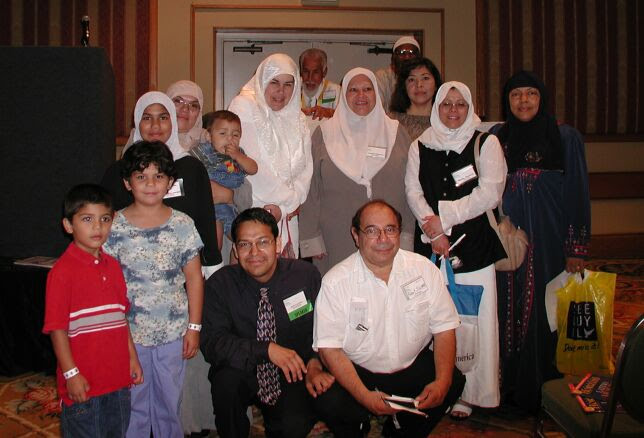y Natasha QuraishiIllumination Magazine, June 2003. Pg 3.www.illuminationmag.org The Latino American Dawah Organization (LADO) is anon-profit organization founded in 1997 that iscommitted to providing information about Islam,particularly to the Latino American community. Withthe increasing number of Latino Americans discoveringor rediscovering Islam, it is a much neededorganization. LADO’s motto is ‘AT YOUR SIDE!’ whichmeans ‘At your side!’ The LADO website, atwww.latinodawah.org, contains a wealth of informationfor prospective reverts and non-Muslims. The sitecontains LADO’s monthly newsletter, useful links onIslamic information and websites, and a library withIslamic resources for beginners in English, Spanish,and Portuguese. From the ‘Contact Us’ page, youcan find Latino Muslims from around the country. Helpacknowledge the diversity
Read MoreBecause 8:45 am is too early for us to be up. Because we are always late, we would have missed all 4 flights. Because pretty people on the plane would distract us. Because we would talk loudly and bring attention to ourselves. Because with food and drinks on the plane, we would forget why we’re there. Because we talk with our hands, we would have put our weapons down. Because we would ALL want to fly the plane. Because we would argue and start a fight in the plane. Because we would have told everyone a week before doing it.
Read MoreNIKE UNVEILS NEW LOGO From Swoosh to ShwooshA Parody. For more Muslim humor check out: azhar.com. Monday Sept 9, 2002 8:37 PM ET By Choam Von Nomsky CHICAGO (Reuters) – Multinational athletic footwear and apparel giant Nike, Inc. [NYSE: NKE] unveiled its new logo today, during a much anticipated press conference held in downtown Chicago at the company’s Michigan Avenue “Nike Town” location. The company announced that its new logo, a mere adaptation of the all-too-familiar “swoosh”, is known as a “shwoosh,” because it incorporates three diacritical marks in the shape of a triangle, just above the fading tail of the swoosh. The
Read MoreWhy to Reject Jesus’ Divinity, A Top Ten List According to the BibleBy Shahid Bin Waheed http://www.geocities.com/sbwus/Top_Ten_List_Rejecting_Jesus-Divinity.htm The Bible gives proof to the Oneness of God, “The Only True God.” 1. In Mark 12:29, Jesus said “Here, O Israel: The Lord our God is one Lord.” [This confirms that Jesus called people to worship the One and Only God, not the trinity. 2. In John 20:17, Jesus said I ascend to my God and your God. [Jesus has a God according to him; we know that a God can’t have a God.] 3. In John 8:28, Jesus said, “I do nothing of myself.” [Can
Read MoreBy Jacob Bender Presented on July 5, 2003 at theISNA Islam in America Conferencesevent in Dallas, Texas As-salaamu ‘alaykum! In the Name of God, the Merciful, the Compassionate. It is truly an honor for me, an American Jew, to stand before this great gathering of Muslims in America this afternoon and recite these sacred words of greetings and peace. I come before you not as a scholar, but as a humble student of the three great traditions that spring from our common father Abraham, peace be upon him, and of the bonds that tie Jew to Christian, Christian to Muslim, Muslim
Read MoreBy Mariam Santos Garcia In the Name of God, The Gracious, Merciful, This presentation is dedicated to our Muslim brothers from Spain from 1492 who gave their lives to protect Al Andalus while trying to maintain their faith in Islam. You are probably wondering why the title of my speech is called Muslims in the Iberian Peninsula and not in Spain, well simply because there was no Spain, nor was Spanish spoken at that time, the territory of the Iberian Peninsula was occupied by the Visigoths , a tribe of Western Goths that came from present-day Germany, while their government
Read MoreBy Shinoa MatosCommUnity Magazinehttp://www.communitymagazine.net July 27, 2003, North Hudson, NJ – On a beautiful Sunday morning (Alhamudullah), North Hudson’s Islamic Educational Center hosted a Latino Muslim event filled with lectures, open discussions, free literature, and dinner to celebrate Islam as part of their Latino heritage. With a huge Latino / Hispanic population in the area, the local Masjid held the event to explain Islam’s deep root in Latino culture and thus how the two are very similar from holding the same values regarding morals and family to the Arabic origins of many Spanish words . After Zhuhr prayer, over 60-70
Read MoreThe Latino Muslims Conference in Dalla By Juan Galvan “We’re here to stay,” I proclaimed. I said those words three times throughout my speech. Afterwards, I wondered how I could say something so ignorant, corny, and so often. Maybe I was simply nervous and searching for words to fill the silence. I wondered and wondered. If I could change things, I would have said, “We’re Latino Muslims, and we’re here to stay. We will create our future regardless, and we need your help to ensure it’s the best future.” However, our Prophet (pbuh) said to avoid using “if”, and Allah (swt) knows best. ISNA’s Latino Muslims conference
Read MoreFallout from 9-11-2001from the prospective of a Latino Muslim. By Khadijah Rivera The World stood still and watched in horror.“Verily with every difficulty there is relief.” – Quran 94: 5-6. It was a regular workday across the USA, and most of us were at work. Then, the world stood still in horror as we discovered that the two World Trade buildings in New York City had been attacked by airplane crashes. The news came slowly as we exchanged bits and pieces of information. Our faces showed the grief of humanity falling apart. Pain was written in our faces and body talk. We dropped our work to
Read MoreBy Samantha Sanchez and Juan Galvan Islamic Horizons MagazineJuly / August 1423/2002 Pages 22-30. The image of Islam in America is changing due to more and more people reverting to it. While there have always been large numbers of both African-American and Caucasian-American populations reverting to Islam, the Muslim population is becoming increasingly diverse. In recent years, the number of Latinos who reverse has increased tremendously. Some figures reveal that 40,000 Latino Muslims live in the United States. Latino Muslims have been gaining media attention. Headlines such as “A New Minority Calls Itself: Hispanic Muslims” and “Hispanic Muslims of New York” are just a
Read MoreBy Samantha Sanchez and Juan Galvan Islamic Horizons MagazineJuly / August 1423/2002, Pp 22-30. The face of Islam is changing in the US as more and more people revert. While there have always been record numbers of African American and Caucasian American reverts, the Muslim community is becoming even more diverse. In recent years, the number of Latino revert has increased significantly. Estimated reports claim that 40,000 Latino Muslims live in the US Latino Muslims have been gaining media attention. Headlines such as “A New Minority Makes Itself Known: Hispanic Muslims” and “Hispanos Musmanes de Nueva York” are just a few that signify that
Read MoreBy Jenn Zaghloul I am a Muslim woman. Feel free to ask me why.When I walk, I walk with dignityWhen I speak I do not lie I am a Muslim woman. Not all of me you’ll seeBut what you should appreciate. Is that the choice I make is free I’m not plagued with depression. I’m neither cheated nor abused.I don’t envy other women. And I’m certainly not confused. Note, I speak perfect English. Et un petit peu de Francais aussi.I’m majoring in Linguistics. So you need not speak slowly. I run my own small business. Every cent I earn is mine.I drive my Chevy to school & work. And
Read MoreBy Jay, A Muslim childhttp://muslimpoet.com/yourpoemschild.htm I is for I believe in AllahS is for Satan is my worst enemyL is for loyal am, I InshallahA is for Allah is my creatorM is for Muslim am I Untitledby Jay From the author: “Please smile while reading.” Being a Muslim is so greatYou don’t get in trouble even if your lateWe love Allah we love our ProphetBecause being a Muslim is so great
Read MoreBy Jason Perez aka Sidi Hamza Abdul Mummit There was this kid named Jealousy who had gun weaponry.Who ever lived life better than him was his enemy.He walked the streets like a centipede.Frustrated with his destinyLiving life like a dark legacy.He had a brother named Envy whose pockets were empty.But he had a 45 caliber with a clip that holds twenty. They made a plan to rob some drug slangers.They ran into a drug dealer named Anger,Known for his short temper by gang bangers.And for his new cars and new clothes on the hangers,They shot Anger and left him dead
Read More“Surely, a Messenger has come unto you from among yourselves; grievous to him is it that you should fall into trouble; he is ardently desirous of your welfare; and to the believers he is specially compassionate and merciful. But if they turn away, say, `Allah is sufficient for me. There is no god but He. In Him do I put my trust, and He is the Lord of the Mighty Throne. ‘” – Quran 9: 128-9. “And He has put affection between their (believers’) hearts. If you hadst expended all that is in the earth, thou couldst not have put
Read More
